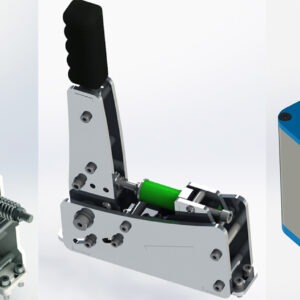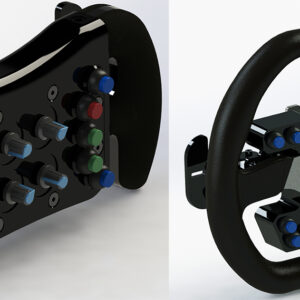How to set effective Sim Racing Setup Guide
Having a well-tuned Sim Racing Setup Guide for your car can be the difference between a mid-pack finish and standing on the podium. While driving skills are paramount, a good setup can help you extract the maximum performance from your car.
This car setup guide will help you to tune up your car in a sim racing simulator, covering everything from suspension to aerodynamics.

Understanding the basics of Sim Racing Setup Guide
Before diving into the details, it’s essential to understand the key components of a car setup and how they influence performance:
- Aerodynamics: Affects downforce and drag.
- Suspension: Influences grip, handling, and tire wear.
- Tires: Manages grip and tire temperatures.
- Brakes: Dictates stopping power and stability.
- Transmission: Controls acceleration and top speed.
- Differential: Affects cornering behavior and traction.
Step-by-Step Car Setup Guide
Tires

Tire management is crucial for maintaining grip and consistency throughout a race.
- Tire Pressure: Affects the contact patch and tire temperature.
- Lower Pressure: Increases grip by enlarging the contact patch but can overheat the tires.
- Higher Pressure: Reduces grip but improves tire longevity.
- Tire Compound: Select the right compound based on race length and track temperature. Softer compounds offer more grip but wear faster, while harder compounds last longer with less grip.
Aerodynamics

Aerodynamics plays a crucial role in high-speed stability and cornering grip. The key elements include the front and rear wings, as well as the car’s overall ride height.
- Front Wing: Increases front-end downforce. A higher setting improves cornering grip but adds drag, reducing top speed.
- Rear Wing: Adds rear-end downforce. A higher setting stabilizes the car in fast corners but also adds drag.
- Balance: Adjust the front and rear wings to maintain a neutral aerodynamic balance. Too much front wing can cause oversteer, while too much rear wing can cause understeer.
- Ride Height: Lowering the ride height increases downforce but may cause the car to bottom out on bumps. Keep it as low as possible without sacrificing stability.
Suspension
The suspension setup affects how the car handles bumps, corners, and weight transfer. It consists of springs, dampers, anti-roll bars, and camber settings.

- Springs: Control how the car responds to weight transfer. Softer springs provide more mechanical grip but can cause body roll. Stiffer springs offer better response but may reduce grip on bumpy tracks.
- Dampers (Shock Absorbers): Control the speed at which the suspension compresses and rebounds.
- Bump: Adjusts how fast the suspension compresses over bumps.
- Rebound: Adjusts how quickly the suspension returns to its original position.
- Anti-Roll Bars: Affect body roll during cornering.
- Front Anti-Roll Bar: A stiffer front bar reduces body roll but can cause understeer.
- Rear Anti-Roll Bar: A stiffer rear bar reduces body roll at the rear but can induce oversteer.
- Camber: Refers to the angle of the tires relative to the road.
- Negative Camber: The top of the tire tilts inward, increasing grip during cornering but reducing straight-line stability.
Brakes
Braking performance is essential for lap times and car stability under braking.

- Brake Balance (Bias): Adjusts the distribution of braking force between the front and rear wheels.
- More Front Bias: Increases stability but may cause understeer.
- More Rear Bias: Helps with rotation but can lead to oversteer or instability.
- Brake Pressure: Controls the overall braking force. Adjust based on track conditions and your ability to modulate braking without locking the wheels.
- Brake Ducts: Manage brake cooling. Open them more on tracks with heavy braking zones to avoid brake fade, but keep them closed as much as possible to reduce drag.
Transmission
The transmission setup affects how the car accelerates and reaches top speed.

- Gear Ratios: Customize the gear ratios to balance acceleration and top speed. Shorter gears improve acceleration, while longer gears provide higher top speed.
- Track-Specific Adjustments: Shorten gears for tight, twisty circuits, and lengthen them for high-speed tracks.
- Final Drive: Adjust the final drive ratio to fine-tune the overall gearing.
Differential
The differential setup controls how power is distributed between the wheels during acceleration, braking, and cornering.
- Power Lock (Acceleration): Controls how much the differential locks under acceleration.
- Higher Setting: Provides better traction out of corners but can induce understeer.
- Lower Setting: Increases rotation but may cause wheel spin.
- Coast Lock (Deceleration): Controls how much the differential locks during braking.
- Higher Setting: Stabilizes the car during braking but may cause understeer.
- Lower Setting: Increases oversteer during corner entry.
Fine-Tuning your Sim Racing Car Setup
Once you have a base setup, fine-tuning is essential to optimize performance for a specific track or race conditions.
Track Analysis

- Track Characteristics: Consider the track’s layout, elevation changes, and types of corners. For example, high-speed tracks may require lower wing settings, while technical tracks benefit from more downforce.
- Sector Focus: Analyze each sector to determine where you can gain time. Adjust the setup to maximize performance in the most critical sectors.
Recommended order of the Sim Racing Setup Guide
To set up a car for sim racing, follow this recommended order:
- Tire Pressure: Ensure the tires are at the correct temperature and pressure for maximum grip.
- Suspension: Adjust ride height, springs, and anti-roll bars to balance the car.
- Alignment: Set camber, caster, and toe for improved stability and steering.
- Differential: Adjust for optimal traction out of corners.
- Aerodynamics: Balance speed and downforce with wing adjustments.
- Brakes: Tune brake bias for effective and stable braking.
- Gear Ratios: Optimize gears for acceleration and top speed based on the track.
Common mistakes and how to avoid them
- Over-tuning: Avoid making too many changes at once. Tweak one parameter at a time to understand its effect.
- Ignoring track evolution: Track conditions change with rubber buildup and temperature. Adjust your setup accordingly during practice sessions.
- Chasing the perfect setup: There is no universally perfect setup. Focus on finding a setup that suits your driving style and the specific track.

Sim Racing Setup Guide: Conclusion
By understanding how each component of the setup influences the car’s performance, you can tune your car to suit your driving style and optimize it for any track. With patience and practice, you can fine-tune your setup to achieve faster lap times, and be more competitive in your races.
-
Product on sale


 Pack: Sequential Shifter, H-Shifter and Sim handbrakeOriginal price was: 23.97€.17.99€Current price is: 17.99€.
Pack: Sequential Shifter, H-Shifter and Sim handbrakeOriginal price was: 23.97€.17.99€Current price is: 17.99€. -
Product on sale


 Pack: DIY F1 Wheel and Button PlateOriginal price was: 15.98€.11.99€Current price is: 11.99€.
Pack: DIY F1 Wheel and Button PlateOriginal price was: 15.98€.11.99€Current price is: 11.99€. -


 DIY Magnetic Paddle Shifters0.00€ (Free)
DIY Magnetic Paddle Shifters0.00€ (Free) -


 DIY Button Plate7.99€
DIY Button Plate7.99€









